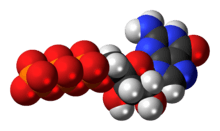Guanosine triphosphate
 | |
 | |
| Names | |
|---|---|
| IUPAC name
((2R,3S,4R,5R)-5-(2-amino-6-oxo-1,6-dihydro-9H-purin-9-yl)-3,4-dihydroxytetrahydrofuran-2-yl)methyl tetrahydrogen triphosphate | |
| Other names
guanosine triphosphate, 9-β-D-ribofuranosylguanine-5'-triphosphate, 9-β-D-ribofuranosyl-2-amino-6-oxo-purine-5'-triphosphate | |
| Identifiers | |
| 86-01-1 | |
| 3D model (Jmol) | Interactive image |
| ChEBI | CHEBI:15996 |
| ChemSpider | 6569 |
| ECHA InfoCard | 100.001.498 |
| 1742 | |
| KEGG | C00044 |
| MeSH | Guanosine+triphosphate |
| PubChem | 6830 |
| |
| |
| Properties | |
| C10H16N5O14P3 | |
| Molar mass | 523.18 g·mol−1 |
| Except where otherwise noted, data are given for materials in their standard state (at 25 °C [77 °F], 100 kPa). | |
| | |
| Infobox references | |
Guanosine-5'-triphosphate (GTP) is a purine nucleoside triphosphate. It can act as a substrate for both the synthesis of RNA during the transcription process and of DNA during DNA replication. Its structure is similar to that of the guanine nucleobase, the only difference being that nucleotides like GTP have a ribose sugar and three phosphates, with the nucleobase attached to the 1' and the triphosphate moiety attached to the 5' carbons of the ribose.
It also has the role of a source of energy or an activator of substrates in metabolic reactions, like that of ATP, but more specific. It is used as a source of energy for protein synthesis and gluconeogenesis.
GTP is essential to signal transduction, in particular with G-proteins, in second-messenger mechanisms where it is converted to guanosine diphosphate (GDP) through the action of GTPases.
Uses
Energy transfer
GTP is involved in energy transfer within the cell. For instance, a GTP molecule is generated by one of the enzymes in the citric acid cycle. This is tantamount to the generation of one molecule of ATP, since GTP is readily converted to ATP with nucleoside-diphosphate kinase (NDK).[1]
Genetic translation
During the elongation stage of translation, GTP is used as an energy source for the binding of a new amino-bound tRNA to the A site of the ribosome. GTP is also used as an energy source for the translocation of the ribosome towards the 3' end of the mRNA.[2]
Microtubule dynamic instability
During microtubule polymerization, each heterodimer formed by an alpha and a beta tubulin molecule carries two GTP molecules, and the GTP is hydrolyzed to GDP when the tubulin dimers are added to the plus end of the growing microtubule. Such GTP hydrolysis is not mandatory for microtubule formation, but it appears that only GDP-bound tubulin molecules are able to depolymerize. Thus, a GTP-bound tubulin serves as a cap at the tip of microtubule to protect from depolymerization; and, once the GTP is hydrolyzed, the microtubule begins to depolymerize and shrink rapidly.[3]
Mitochondrial Function
The translocation of proteins into the mitochondria matrix involves the interactions of both GTP and ATP. The importing of these proteins plays an important role in several pathways regulated within the mitochondria organelle.[4]
Biosynthesis
In the cell, GTP is synthesised through many processes including:
- as a byproduct of the Succinyl-CoA to Succinate conversion catalysed by the Succinyl-CoA synthetase enzyme as part of the Krebs cycle;[1]
- through exchanges of phosphate groups from ATP molecules by the Nucleoside-diphosphate kinase, an enzyme tasked with maintaining an equilibrium between the concentrations of different nucleoside triphosphates.[1]
cGTP
Cyclic guanosine triphosphate (cGTP) helps cyclic adenosine monophosphate (cAMP) activate cyclic nucleotide-gated ion channels in the olfactory system.[5]
See also
References
- 1 2 3 Berg, JM; JL Tymoczko; L Stryer (2002). Biochemistry (5th ed.). WH Freeman and Company. p. 476. ISBN 0-7167-4684-0.
- ↑ Solomon, EP; LR Berg; DW Martin (2005). Biology (7th ed.). pp. 244–245.
- ↑ Gwen V. Childs. "Microtubule structure". cytochemistry.net.
- ↑ Sepuri, Naresh Babu V.; Norbert Schülke; Debkumar Pain (16 January 1998). "GTP Hydrolysis Is Essential for Protein Import into the Mitochondrial Matrix". Journal of Biological Chemistry (273): 1420–1424. doi:10.1074/jbc.273.3.1420.
- ↑ Boron & Boulpaep (2005). Medical Physiology (Updated ed.). Elsevier Saunders. p. 90. ISBN 1-4160-2328-3.
External links
| Wikimedia Commons has media related to Guanosine triphosphate. |
- GTP bound to proteins in the PDB